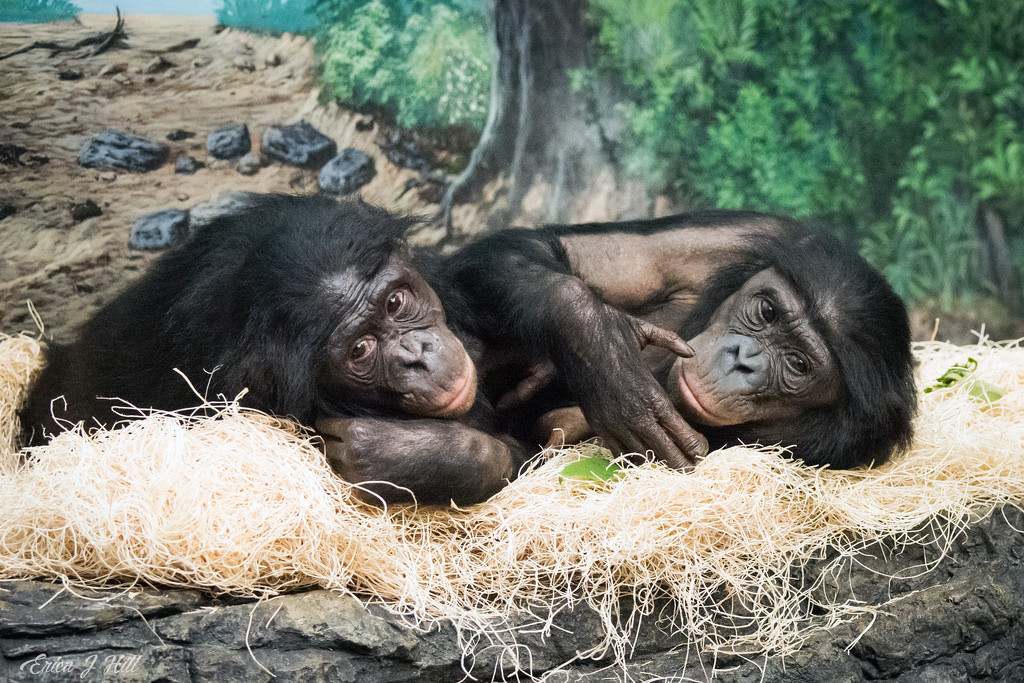Be A Bonobo Valentine as the Cincinnati Zoo Celebrates World Bonobo Day on February 14!
 On Feb 14, Valentine’s Day, the Cincinnati Zoo & Botanical Garden (CZBG) and conservation organizations across the planet recognize the 2nd annual World Bonobo Day. Very appropriate day considering the bonobos’ affinity for “extreme closeness” with each other. This charismatic species of primate has been part of our community here in Cincinnati since the late 80s. CZBG has had the honor to share bonobos with millions of guests, friends and followers over those many years. Although the focus, goals and how we care for these great apes has evolved greatly, one constant has held firm throughout; their compelling ability to engage and inspire all of us to care. One look into the deep, contemplative eyes of a bonobo and you realize the undeniable kindred connection to ourselves. When digging a bit further, we discover this connection goes far beyond just our physical similarities.
On Feb 14, Valentine’s Day, the Cincinnati Zoo & Botanical Garden (CZBG) and conservation organizations across the planet recognize the 2nd annual World Bonobo Day. Very appropriate day considering the bonobos’ affinity for “extreme closeness” with each other. This charismatic species of primate has been part of our community here in Cincinnati since the late 80s. CZBG has had the honor to share bonobos with millions of guests, friends and followers over those many years. Although the focus, goals and how we care for these great apes has evolved greatly, one constant has held firm throughout; their compelling ability to engage and inspire all of us to care. One look into the deep, contemplative eyes of a bonobo and you realize the undeniable kindred connection to ourselves. When digging a bit further, we discover this connection goes far beyond just our physical similarities.
Bonobos are man’s closest living relatives, sharing over 98% of the same DNA. Although certainly not an ancestor of humans, they have followed along on a common path throughout the centuries. Using special adaptations like stereoscopic vision, dexterous hands, opposable thumbs and the largest brains per body mass, apes like humans have developed dynamic social structures and can effectively manipulate their environments to suit their needs, key to their success.
Here at the zoo, bonobos are considered conservation anchor species. These highly intelligent, clever apes connect with guests at the zoo’s rainforest immersion habitat, “Jungle Trails”. CZBG has been one of the primary supporters of bonobo conservation in North America and has produced 10 births! We work closely with other zoos and the AZA’s Species Survival Plan to cooperatively manage this endangered species while learning all we can about them through collaborative health and behavioral research. CZBG is known as experts in the care of bonobos and staff members serve on national bonobo management committees. Bonobos are never removed from the wild for North American accredited zoos so genetics and welfare are meticulously managed. Currently there are only about 5000-10,000 in the wild and they are considered endangered. There are approximately 90 in north American Zoos. Very rare and special to see!
Closely related to chimpanzees, bonobos diverged from their more physically robust and behaviorally aggressive counterparts as they developed their “make love, not war” communities. Found only in the Democratic Republic of Congo (DRC) and isolated from other ape species, bonobos have been dubbed the “hippie apes”. Unlike the other ape species, female bonobos are receptive for breeding anytime. Competition from males for female attention diminished, allowing a matriarchal order led by strong female coalitions. Bonobos diffuse tensions and bond through frequent breeding behaviors, embracing and long grooming sessions. Unfortunately, this Shangri-La society is threatened by continued deforestation and expansive mineral mining. Columbite-tantalite or coltan is mined extensively for use in our cell phones. The mining practices there create many human welfare issues and contribute to the decline of bonobo populations as they are being consumed as bushmeat or food by the workers. It’s a complex and challenging problem. To help, CZBG has partnered with Eco-Cell to collect and recycle old cell phones and cell phone products. By reusing coltan, we reduce the need for as much of it to be taken from bonobo and gorilla habitats and the profits made are then reinvested back into to our wild ape conservation efforts in Central Africa. You can learn more at www.cincinnatizoo.org.
Another critical commonality between humans and bonobos is the life sustaining need for healthy rainforests across the planet. Although they only cover about 2% of Earth’s surface they are home to over half of all plant and animal species. Referred to as the “Lungs of the Planet”, they produce a disproportionate percentage of our oxygen and serve as great water reservoirs, distributing rainfall for us all. They diffuse light reflection from the sun important to maintaining climate balance. Many of the common medications and drugs we depend on were derived from rainforest plant species with other uses waiting to be discovered. Unfortunately, rainforests are being cut down at an unsustainable rate across the globe. Of course, apes have a more direct need for rainforests, depending on them for their very lives. Bonobos and the other apes are “gardeners of the rainforest” and critical to their vitality. Through continuous foraging they stimulate fresh new growth while spreading seeds in their dung as they travel great distances across the forest. Rainforests can’t thrive without apes, humans cannot thrive without rainforests.
 The Cincinnati Zoo is dedicated to the mission of inspiring guests with apes while providing the highest quality care, state of the art facilities, participating in research and supporting in situ conservation (field projects). We are dedicated to channeling that inspiration to learn more and take action. Recycle, reuse, repurpose, reduce everything possible in our everyday lives! Recycle cell phones with us to make a direct impact on bonobo conservation and support eco-tourism by visiting apes in the wild if you can. Together we are and can continue to make a difference. Visit the zoo’s website for more information about our environmental sustainability efforts.
The Cincinnati Zoo is dedicated to the mission of inspiring guests with apes while providing the highest quality care, state of the art facilities, participating in research and supporting in situ conservation (field projects). We are dedicated to channeling that inspiration to learn more and take action. Recycle, reuse, repurpose, reduce everything possible in our everyday lives! Recycle cell phones with us to make a direct impact on bonobo conservation and support eco-tourism by visiting apes in the wild if you can. Together we are and can continue to make a difference. Visit the zoo’s website for more information about our environmental sustainability efforts.
Also look for special and fun enrichment activities with the bonobos this Valentine’s Day.


